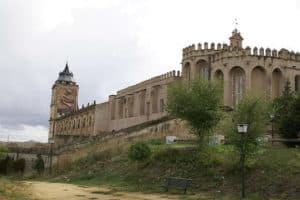
Seville, Spain
Dr. Stephen Nichols takes us to an unlikely place where the Reformation took hold: Seville, Spain.
 For the next three weeks, we’re going to take a tour of unlikely places where the Reformation took hold. The first location is Seville, Spain. We often talk about Geneva and Cambridge and Wittenberg, but let’s talk about Seville. We could talk about Seville for its role in literature. Miguel de Cervantes spent three months in custody there during which it is believed that he thought up his famous character Don Quixote. And where would opera be without Seville, Spain? Someone tallied it up and came up with a figure of about one hundred and fifty operas that have Seville as their setting. The Marriage of Figaro by Mozart, The Barber of Seville by Rossini, Bizet’s Carmen, and even Beethoven’s Fidelio take Seville as their setting.
For the next three weeks, we’re going to take a tour of unlikely places where the Reformation took hold. The first location is Seville, Spain. We often talk about Geneva and Cambridge and Wittenberg, but let’s talk about Seville. We could talk about Seville for its role in literature. Miguel de Cervantes spent three months in custody there during which it is believed that he thought up his famous character Don Quixote. And where would opera be without Seville, Spain? Someone tallied it up and came up with a figure of about one hundred and fifty operas that have Seville as their setting. The Marriage of Figaro by Mozart, The Barber of Seville by Rossini, Bizet’s Carmen, and even Beethoven’s Fidelio take Seville as their setting.
But what of the Reformation? Seville is deep in Roman Catholic Church territory, so the story of Protestants in Seville is a story of persecution. On September 24, 1559, nineteen so-called heretics were burned at the stake by officials of the Inquisition. It was actually eighteen persons and one person in effigy who had died previously while in custody. In fact, not only was he burned in effigy, but his bones were dug up and they were burned too. Nineteen in all were martyred for the faith. The next year on December 22, 1567, seventeen more were martyred as heretics as identified by the Roman Catholic Church, but these were Protestant Reformers.
How did this Reformation, even in miniature, penetrate to Seville? First, it came in the form of a person. Juan Gil, who was known as “Doctor Egidio,” was born in 1500. As a student in the 1520s, he came under the influence first of Erasmus and Erasmus’s criticisms of the Church, and then he came under the influence of Luther and Luther’s doctrine and the Reformation principles. In 1545, Egidio was appointed a bishop in Seville, and by then he was espousing Reformed positions. Then came the Inquisition. He was taken into custody, was tried, and he died while in custody in 1555. It was later in 1559 that they dug up his body and they burned his bones.
So, the Reformation came first to Seville in a person. It also came to Seville in a book. In 1556 Juan Pérez de Pineda translated the New Testament into Spanish. He did this from his base in Geneva. His many months of translation were all funded by the good folks there in Calvin’s church in Geneva. Then, once it was complete, these folks in Geneva paid to print up all these copies, and they smuggled it into Spain. One of those smugglers was Julián Hernández. Someone tipped off the Inquisitors and they arrested Hernández. They confiscated his supply of New Testaments, and he too was martyred for his faith. And so that is the tragic story of the Reformation, these martyrs in 1559 and in 1560.
Over the next few years, several more Protestants were martyred in Seville, Spain. It wasn’t Geneva, it wasn’t Wittenberg, it wasn’t Cambridge, but nevertheless, the light of the gospel did come to those few who were in Seville, Spain. That concludes the first location of our tour of unlikely places where the Reformation occurred.
Stay connected with 5 Minutes in Church History by getting the weekly podcast on iTunes, SoundCloud, or via RSS. You can also subscribe to the blog via RSS and follow us on Twitter and Facebook.
(This podcast is by Ligonier Ministries. Discovered by Christian Podcast Central and our community — copyright is owned by the publisher, not Christian Podcast Central, and audio is streamed directly from their servers.)